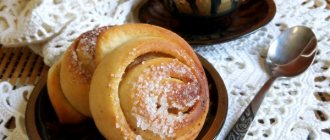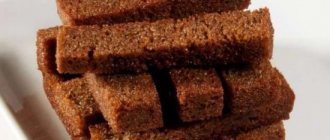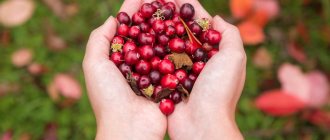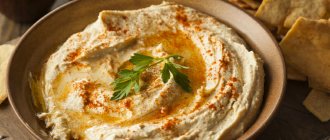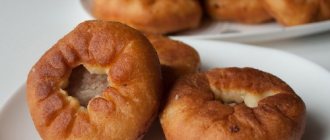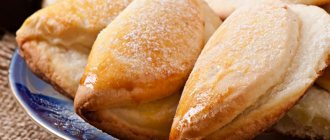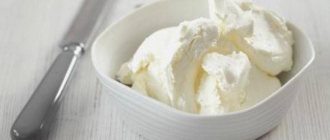Calorie content of Ciabatta bread. Chemical composition and nutritional value.
Nutritional value and chemical composition of “Ciabatta bread”.
| Nutrient | Quantity | Norm** | % of the norm in 100 g | % of the norm in 100 kcal | 100% normal |
| Calorie content | 262 kcal | 1684 kcal | 15.6% | 6% | 643 g |
| Squirrels | 7.7 g | 76 g | 10.1% | 3.9% | 987 g |
| Fats | 3.8 g | 56 g | 6.8% | 2.6% | 1474 g |
| Carbohydrates | 47.8 g | 219 g | 21.8% | 8.3% | 458 g |
| Macronutrients | |||||
| Silicon, Si | 2.2 mg | 30 mg | 7.3% | 2.8% | 1364 g |
| Microelements | |||||
| Bor, B | 48 mcg | ||||
| Yod, I | 3.2 mcg | 150 mcg | 2.1% | 0.8% | 4688 g |
| Manganese, Mn | 0.825 mg | 2 mg | 41.3% | 15.8% | 242 g |
| Selenium, Se | 6 mcg | 55 mcg | 10.9% | 4.2% | 917 g |
| Zinc, Zn | 1 mg | 12 mg | 8.3% | 3.2% | 1200 g |
The energy value of ciabatta bread is 262 kcal.
Main source: Skurikhin I.M. and others. Chemical composition of food products. Read more.
** This table shows the average levels of vitamins and minerals for an adult. If you want to know the norms taking into account your gender, age and other factors, then use the “My Healthy Diet” application.
What are the benefits of ciabatta bread?
- Manganese
is involved in the formation of bone and connective tissue, and is part of enzymes involved in the metabolism of amino acids, carbohydrates, and catecholamines; necessary for the synthesis of cholesterol and nucleotides. Insufficient consumption is accompanied by slower growth, disturbances in the reproductive system, increased fragility of bone tissue, and disturbances in carbohydrate and lipid metabolism.
You can see a complete guide to the healthiest foods in the “My Healthy Diet” app.
- home
- Product composition
- Composition of bread and pastries
- Chemical composition of “Ciabatta bread”
Tags:
Ciabatta bread calorie content 262 kcal, chemical composition, nutritional value, vitamins, minerals, health benefits Ciabatta bread, calories, nutrients, beneficial properties Ciabatta bread
Energy value, or calorie content
- this is the amount of energy released in the human body from food during the digestion process. The energy value of the product is measured in kilocalories (kcal) or kilojoules (kJ) per 100 grams. product. The kilocalorie used to measure the energy value of food is also called a food calorie, so when caloric content is reported in (kilo)calories, the prefix kilo is often omitted. You can see detailed energy value tables for Russian products here.
The nutritional value
— content of carbohydrates, fats and proteins in the product.
Nutritional value of food product
- a set of properties of a food product, in the presence of which the physiological needs of a person for the necessary substances and energy are satisfied.
Vitamins
, organic substances required in small quantities in the diet of both humans and most vertebrates. Vitamin synthesis is usually carried out by plants, not animals. A person's daily requirement for vitamins is only a few milligrams or micrograms. Unlike inorganic substances, vitamins are destroyed by strong heat. Many vitamins are unstable and are “lost” during cooking or food processing.
Ciabatta bread
Ciabatta is an Italian white bread made from wheat flour and yeast. Translated from Italian, this word literally means “carpet slippers,” flip-flops or boots, and this sweet product is not called that because of its shape, as is mistakenly believed. The Italian expression cucinare uno ciabatta is similar to the Russian to make legs.
The peculiarity of this bread is its crispy crust and pulp with large, unevenly distributed porosity. Since the late 1990s, this type of bread has become very popular in Europe and the USA and has begun to be widely used for making sandwiches.
Ciabatta was originally baked only in Liguria, but nowadays this type of bread is widespread throughout Italy and even beyond it, for example in Spanish Catalonia, where it is popular under the name chapata. Ciabatta, baked in the Lake Como region, has a crisp crust, soft, spongy texture, and light bread. Ciabatta, baked in the regions of Tuscany, Umbria and Marche, can be completely different - from bread with a hard crust and dense pulp, to bread that is softer and lighter (calorizer). In the United States, people generally prefer to bake ciabatta with a wetter dough, which requires machine kneading and the addition of special enzymes and leavening.
Used in recipes:
Baked Ciabatta bread with side dish
| Navigation: All recipes |
- Countries of the world Location, area, flags, rivers, mountains, seas, capital, cities, population, area, currency
- Geography test: continents Do you know where your country is? Which continent are you going to go on vacation?
- Memory test We offer you a free test of your memory, a method of memorizing pictures
- Large IQ test When performing the test, you cannot use paper, a calculator, a pen, a cheat sheet, the Internet, or tips from a friend.
- Test: Flags The greater the number of questions, the higher the accuracy of the test result!
- IQ test The IQ test lasts 30 minutes and contains 40 simple questions!
- Clairvoyance Test You must concentrate and try to guess where the ace is hidden!
- Road signs of the Russian Federation Test for knowledge of Road signs according to traffic rules (traffic rules)
- Borders and neighboring countries Take a test to test your knowledge of neighboring countries. Find out which countries border the country where you are planning to go on vacation
Free games online · Eng · CZ Hry · Games online for free · Icon on your Web · Visitors' book · RoboStav Copyright (c) 2020 by Topglobus.ru. All rights reserved!
Ciabatta
Ciabatta appeared on store shelves not long ago. This Italian bread has attracted the interest of many not only for its name, but also for its taste. Ciabatta is made from premium wheat flour and yeast. Actually, like other white bread. It is very easy to distinguish it from other loaves, since ciabatta looks like two elongated flatbreads. This form of baking is explained by its origin. In Italian, ciabatta means “carpet slippers.”
How to prepare ciabatta
The original recipe, of course, is known to the inventor. By the way, Cavallari copyrighted it and registered the name. If you are in Italy, in the town of Bottrige, you can attend Arnaldo’s master class and see with your own eyes the birth of real ciabatta (and remember the technology, of course).
Classic ciabatta
water – 330 g salt – teaspoon dry yeast – eighth of a teaspoon high protein flour – 250 g semolina – 150 g olive oil – 1 teaspoon
The dough is kneaded with a mixer at high speed for 10-20 minutes (this is an important part of the process) and left to ferment in a warm place, covered with film. Fermentation should last 10-12 hours, and readiness is determined by the moment of its maximum rise. As soon as the level of the dough begins to decrease, the ciabatta must be prepared for baking, otherwise the dough will ferment and the bread will fail.
From the container in which the dough was proofed, it is transferred to a table well sprinkled with flour, or even better, semolina. Divide into two parts (do not knead the dough, work carefully with it as it is!). After a half-hour rest, the pieces are transferred to a baking sheet with parchment and placed in a hot oven.
You need to maintain humidity inside the oven so that the crust dries slowly and remains thin.
The bread is baked for 30-35 minutes, and the finished ciabatta produces a characteristic dull sound when tapped.
Fermented dough gives the bread a noble, slightly sour “homemade” taste and aroma.
By the way, ours will go perfectly with this wonderful Italian bread. Great lunch with a mix of styles!
Quick ciabatta at home, simple recipe
- 225 g water;
- salt – 1.25 tsp;
- dry yeast – 1 tsp.
All ingredients are poured into the bowl of a food processor or mixed in a bowl suitable for using a mixer. Knead the dough at high speed for about 20 minutes. Intensive kneading greatly changes the structure of the dough. If at first it turns out to be liquid, then by the end of the kneading it becomes thick and very elastic, literally wrapped around the blades and collected towards the center of the bowl.
The dough is allowed to rise in a warm place under film. The duration of fermentation depends on the yeast - the finished dough should become liquid again and begin to bubble strongly. The further baking procedure is the same as for classic ciabatta. Important details:
- The preparations are placed on a heated baking sheet.
- To maintain the required humidity, place a container of water on the bottom of the oven. The sooner you remove the water, the thicker the crust will be.
- Semolina is crushed wheat kernels. It differs from semolina in that it is made from durum wheat. If you don’t have semolina, you can use semolina, although this will be a small deviation from the original recipe.
- Overcooked dough does not rise well in the oven. When preparing bread according to the classic recipe, do not miss the moment of highest rise.
- Do not reduce the kneading time - this significantly reduces the quality of the finished bread. High protein content in flour (strong flour) is 13% or higher.
- There is little yeast in the classic ciabatta recipe. This is not a mistake, but a consideration of the fact that the dough will ferment for a long time.
Composition of ciabatta
Ciabatta contains several vitamins and minerals. Bread contains a large amount of folic acid, vitamins A, B1, B2, B6, B9, E. 100 grams of this baked goods contain 7.7 grams of protein, 3.8 grams of fat and 47.8 grams of carbohydrates. The composition of ciabatta also boasts the presence of amino acids. Among them: lysine, glycine, methionine, valine, phenylalanine, etc., as well as minerals such as calcium, phosphorus, zinc, magnesium, etc. The calorie content of ciabatta is low when compared with other types of bread. It contains 222 kcal per 100 grams.
Ciabatta bread has a crispy crust and tender pulp with unevenly distributed pores. Baked goods are used to make sandwiches, sandwiches, snacks, or eaten just like that. Ciabatta can be eaten in combination with salads, soups, ham, and is also served with wine and cheese.
Ciabatta bread - beneficial properties and calorie content. Ciabatta: calorie content per 100 grams
Ciabatta bread contains a large amount of folic acid, vitamins E, A and group B. This bakery product is rich in amino acids, among which lysine, glycine, methionine, valine, phenylalanine, etc. occupy a special place, as well as minerals such such as: calcium, phosphorus, zinc, magnesium, etc.
100g of Ciabatta bread contains:
- Proteins – 7.7.
- Fats – 3.8.
- Carbohydrates – 47.8.
- Kcal – 262.
Ciabatta is bread with a crispy crust and pulp with unevenly distributed pores. This type of bread, such as Ciabatta, is used for making sandwiches, snacks, and sandwiches. It is served with first courses and salads, combined with cheese, wine and ham.
Interesting facts from the history of Ciabatta bread
Ciabatta baking began in Liguria, but today this baked product is baked throughout Italy, and in Spanish Catalonia this type of bread is called Chapata. Ciabatta baked in Tuscany, Marche, and Umbria is strikingly different from one another in pulp, crust, and composition.
The main secret to baking this bread is to use live yeast and rise the dough for 12 hours or more.
Classic Italian Ciabatta is baked in a special oven. Modern housewives use a flattened stone, which they place in the oven, heat it, and then place a baking sheet on it with the Ciabatte prepared for baking.
Ciabatta comes in several varieties:
- Made from whole wheat flour (ciabatta integrale).
- With the addition of olive oil, marjoram and salt.
- Ciabatta with milk (ciabatta al latte).
Useful properties of Ciabatta bread
Ciabatta dough is aged for about 12 hours. Over such a long time, it becomes homogeneous, and the yeast contained in this dough matures completely. Because of this, this bakery product is considered useful for people with gastritis, duodenal ulcers, as well as those with weakened intestinal motility.
Ciabatta is included in all kinds of diets, because this bread is light on the stomach, but not in large quantities, since it is high in calories.
Ciabatta bread is useful for a weakened body with low immunity, as well as during the postoperative period.
Bakels Nordic Brad Mix
Bread mixes
More than 1000 years have passed since the Vikings introduced the world to rye bread, which occupies a central place in ...
View product
Mix for preparing bakery products Grovekorn
Bread mixes
Basic mixture for dark rye bread, enriched with dietary fiber. The finished product has an attractive appearance, rich taste and aroma. Recommended for baking...
View product
Mix for preparing bakery products Regofin
Bread mixes
A dark bread base containing rye. It has a rich aroma and is suitable for making bread and rolls.
View product
Mix for preparing baked goods Toast Base
Bread mixes
A base for white toast bread with excellent ability to retain freshness and rich aroma.
View product
Mix for preparing baked goods Boachia
Bread mixes
Concentrated mixture for traditional Italian bread with aroma and crispy crust. Economical dosage.
View product
Mix for preparing baked goods Gourmet
Bread mixes
Bread base with high baking properties.
View product
Mix for preparing bakery products Grain mixture
Bread mixes
Multicomponent grain mixture for decorating bakery products. Can also be used in dough kneading.
View product
Mix for preparing baked goods Yoga
Bread mixes
Bread base with dietary fibre, malted wheat flakes and bran with flavour. Suitable for all types of bread.
View product
Mix for preparing baked goods Maize Brad
Bread mixes
A mixture with whole pieces of corn, which gives the bread its characteristic taste and rich color. Convenient to use for making a wide range of bakery products…
View product
Mix for preparing bakery products Megaofin
Bread mixes
A mixture for preparing baked goods with grains and dietary fiber, containing omega-3 and omega-6 fatty acids.
View product
Mix for preparing baked goods Oats and Barley
Bread mixes
Multicomponent mixture for the production of bread with a thoughtful combination of raw materials. The uniqueness of baked goods from the mixture are: Great taste, excellent texture. ...
View product
Mix for making baked goods Chia Mix
Bread mixes
Bread mix containing chia seeds and flax seeds. High Omega 3 and Antioxidant Content in Chia Seeds...
View product
Mix for preparing bakery products Universe Mix
Bread mixes
Special base for preparing baked goods.
View product
Artisan bread mix
Bread mixes
Artisan Bread Mix is a clean label powder concentrate with added starter to produce high quality rustic breads, baguettes,...
View product
Recipe in the oven
Foreign delicacies have always attracted domestic culinary experts. Ciabatta is no exception in this regard. And, although store shelves are full of Italian bread from Russian producers, the desire of housewives to acquire their own recipe does not fade. We present to your attention a classic option for preparing ciabatta in the oven.
The test preparation process is divided into two stages. On the first of them the leaven is made, on the second - the dough itself. So, the ingredients needed for sourdough:
- Flour from fine soft wheat varieties – 300 g;
- Water – 300 ml;
- Dry yeast – 2 g.
Components for stage 2:
- Flour from fine soft wheat varieties – 600 g;
- Water – 350 ml;
- Dry yeast – 3 g;
- Malt or sugar – 10 g;
- Salt – up to 20 g;
- Whole wheat flour for dusting.
It is worth mentioning that if you have the opportunity to buy Italian-made flour, then choose grade 00 for ciabatta.
Sourdough in appearance resembles pancake batter. To prepare it, we dissolve dry yeast in water heated to 40 degrees (alternatively, you can take 6 g of fresh yeast). Sift the flour into a bowl. We combine everything by pouring the liquid into the flour.
Stir with a wooden spoon until the mixture becomes homogeneous and very soft. Cover the dish with plastic wrap and leave at room temperature for about 3 hours. After the required time has passed, the starter will fill with air bubbles and darken slightly.
Let's move on to stage No. 2. Dissolve dry yeast (or 9 g fresh) and malt (sugar) in warm water. Leave to activate for 15 minutes. Pour the liquid into the starter and stir with a wooden spoon. Next, add sifted flour and salt in portions. When the dough begins to thicken, continue kneading by hand for 15-20 minutes until smooth.
Transfer the dough to a bowl, cover with cling film and leave at room temperature (about 25 degrees) for 1 hour. After the time has passed, transfer the mixture to a work surface sprinkled with whole grain flour. We flatten it in the form of a rectangle, which we fold in half, first along and then across.
We divide the entire volume into 10 parts (each weighs 150-160 g), form cylinders and lay them out on the work surface. Cover with film and leave to rise for 1-1.5 hours in a warm place. At the end, the loaves should double in volume.
Carefully stretch the pieces of dough to a ciabatta shape and transfer to a baking tray lined with baking paper. Spray the walls of the oven preheated to 240-250 degrees (if there is a fan, then to 220-230) with water 5-6 times using a spray bottle. This preparation will prevent premature crust formation.
Bake the “slippers” for 8 minutes, then reduce the temperature to 200 (180) degrees and bake for another 8 minutes. Next, continue cooking for another 3-4 minutes, without lowering the temperature, but opening the oven door slightly. Improvised convection will allow excess steam to escape and contribute to the formation of a crispy crust.
Let the finished baked goods cool and eat to your heart’s content.
Recommendations
A few simple recommendations will help you make the process of making homemade ciabatta a little easier:
- Since the dough for airy bread is saturated with moisture, it is wet and sticks to your hands. So place a bowl of water next to your work surface. Lightly wet your hands before handling the dough. This will prevent sticking.
- Don't worry if the loaves look flat and unpromising on the baking sheet before baking. As the water heats up and evaporates, air bubbles form, which will “make” your bread rise.
- Ideally, it is better to knead the dough using a planetary mixer or bread maker. Due to the high humidity it is inconvenient to work with manually
- It is better to store finished baked goods in fabric bags for 2-3 days. But ciabatta can be frozen in the refrigerator and used as needed, after letting it “come to life” in the oven for a few minutes.
Ciabatta with potato broth
Category: Baking Dough products Homemade bread
No kneading. Sourdough. Sooo delicious! No unnecessary movements, she prepares practically herself, under time pressure)))
Ingredients
Ingredients: Sourdough Broth Wheat flour Olive oil
svetlik
February 4, 2020
Sourdough Broth Wheat flour Olive oil
Ingredients:
- Flour - 400 grams
- Water – 330 Milliliters
- Salt - 0.5 teaspoons
- Olive oil - 1 teaspoon
- Dry yeast - 1 pinch
Number of servings: 4-5
Features of light bread
Italians believe that ciabatta only improves digestion, in moderation does not affect the figure, and contains many useful substances. For example, in one loaf you can find the following:
- Vitamins of groups “A”, “E” and “B”;
- Folic acid;
- Phosphorus;
- Calcium;
- Magnesium;
- Zinc;
- Amino acids.
Not every modern bread contains such a rich set of various microelements. There are only 262 calories in 100 grams of ciabatta bread. The starter for the dough is made only from “live” yeast, and the dough for this bread rises for 12 hours. This is the only way to obtain a crumb with large pores and cavities.
Initially, stone ovens were used to bake ciabatta. Today, some Italian bakeries are trying to prepare unique bread in this way, which helps to increase the number of visitors to the establishment.
Ciabatta is a product that modern civilization has not had time to spoil. The bread recipe contains all the same ingredients as several centuries ago, and its form, like a real bread brand, remains unchanged. You can try ciabatta not only in Italy and its surroundings. This pastry is served in many restaurants around the world. Sometimes ciabatta can be found in eateries as a base for sandwiches.
(1 5,00
Source: https://tuberkulezkin.ru/diety/hleb-chiabatta-kalorijnost-sostav-i-retsept-prigotovlenie-v-domashnih-usloviyah.html
The benefits of ciabatta
A prerequisite for preparing Ciabatta is allowing the dough to sit for 12 hours. It is precisely these time frames that must be observed so that the dough can become homogeneous, nourished, and the yeast that is part of the ciabatta is fully matured. All these nuances make ciabatta so tasty and fluffy, and also provide it with beneficial properties.
It is believed that ciabatta is useful for people who have gastritis, intestinal diseases, duodenal ulcers, as well as those who have weakened intestinal motility. This bread is often included in special diets, as it is easy to digest. It is impossible to say that ciabatta is effective for weight loss, however, the fact that it contains much fewer calories than regular bread is unambiguous. The calorie content of ciabatta makes it a good substitute for regular bread.
Ciabatta bread is useful for a weakened body with low immunity, as well as during the postoperative period.
Making Italian Ciabatta.
Despite the fact that the bread is considered Italian, the first versions of ciabatta were prepared in Liguria. Today, such bread is prepared in many countries, including Italy and Spain (where such bread is called Chapata). The recipe for Ciabatta is known in Tuscany, Marche and Umbria. However, there this bread has a slightly different composition and taste. The basic rule that is included in the ciabatta recipe is to use only fresh yeast. It is important that the ciabatta dough must rise for at least 12 hours.
Italians know how to make ciabatta. They use a special oven to ensure the bread is the shape and texture they require. But modern housewives have gotten used to using a flattened stone, which is placed in the oven, heating it. Only then do they place the baking tray with the Ciabatte prepared for baking on it. There are several types of ciabatta. Among them:
- Made from whole wheat flour (ciabatta integrale).
- With the addition of olive oil, marjoram and salt.
- Ciabatta with milk (ciabatta al latte).
Application
This bread can now be bought in any store, but for those who like to do everything with their own hands, there is a little secret. To ensure the bread bakes evenly, place a flat stone on the bottom of the oven and wait for it to heat up. Then place the baking sheet directly on the stone.
Ciabatta bread will be the highlight of your table both on holidays and on weekdays. It will perfectly complement and highlight the taste of soup or second, and is also suitable for sandwiches, toast and other snacks.
Market Analytics
- COVID-19 is changing the rules of the game in the cosmetics market
- Beauty of the future: cosmetic innovations 2020
- New ingredients are the driving force of the cosmetics industry
Convenient search for beauty salons on our website
Beauty salons in Moscow Beauty salons in St. Petersburg Beauty salons in Ekaterinburg Beauty salons in Novosibirsk
Latest blog posts on our website
- Naturecream / Geranium (Pelargonium) oil for skin health and beauty
- Prostye-sovety / Save on a beauty salon: procedures that can be done at home
- Naturecream / Growth Factor - brings back youth?
- Oksana-Lezina / 3 effective abdominal exercises from a fitness instructor for beginners
- Prostye-sovety / Making perfect curls at home
- Prostye-sovety / Which hair removal method to choose
- Naturecream / Wrinkles Puppets
- Naturecream / PEPHA-TIGHT - instant skin lifting
- Naturecream / Blue light - a danger to the skin
- Naturecream / Cocoa Butter – A treat for the skin
Latest forum topics on our website
- Mrs._Smith / Badly sunburned! What to do?((
- Ice / Is it necessary to combine fitness classes with a diet?
- Antonova / What can be used for hair loss?
- Radio operatorKat / Who was on a protein diet?
- Suzanna / Mesotherapy on the face
Other articles in this section
| Garlic bread Bread is the head of everything. This saying carries great semantic meaning, because this product has more than once saved people from starvation. Today, bread and bakery products remain the most important products of humanity. |
| Shangi Many, mistakenly, believe that this is an original Russian dish. In fact, the name is borrowed from the language of the Finnish tribes, who lived together with the Slavic peoples in the Russian North. Around the 17th century, according to references found in chronicles, “shangas” began to spread from Karelia to the Ob and to Western Siberia. This culinary product has been preserved in its original form in the cuisine of the peoples of the Trans-Urals and Middle Urals; it is little known in Western Russia. |
| Rye bread As history tells, the bread that the Russian people prepared was made from rye flour. This product was first prepared in the 11th century. And since then, all Russian people have bought rye bread, regardless of their social status and monthly income. The product was available to everyone. |
| Vysivkovy Bread Bread baked with the addition of bran or from whole grain flour is called vysivkovy. The name “vysivkovy” comes from Ukraine - that’s what they call the grain shells there. But more often they are called simpler and more familiar - bran. The first mentions of such bread were found in Ancient Egypt. Vysivkov bread was eaten by people belonging to the simple, poor strata of the population, since this type of bread was the cheapest and most accessible. |
| Bread with dried fruits When and where people first began adding dried fruits to bread has not been reliably established. But many peoples use this useful product in their national cuisine. This includes Tyrolean bread, to which raisins, figs, prunes and almonds are added. And Swabian bread with sunflower seeds and any dried fruit to taste. All types of such bread have one thing in common - it is very tasty and healthy. |
| Focaccia The classic national wheat flatbread in Italy is called focaccia - “bread baked in the hearth (or in ash).” She was also nicknamed the progenitor of pizza because of her great similarity. In ancient times, focaccia was the food of warriors and peasants. Modern focaccia can be spicy, salty and even sweet. The shape of focaccia is traditionally round, but it can also be rectangular or triangular. |
| Bread with seeds Nowadays, there are many different types of bread. One of them is bread with seeds. Pumpkin seeds and sunflower seeds are added to it, and sesame is also used. Most often, milk and eggs are not used to make this bread. |
| Ukrainian bread In Ukraine, as well as in Russia, bread is the most important product. Almost no meal is complete without it. Without bread, even the most satisfying dish seems incomplete. And Ukrainian bread is a wonderful, balanced product, rich in a wide variety of nutrients. |
| Malt bread Bread is one of the oldest products of mankind. Despite this fact, it continues to be the most important product in our lives. In many countries, bread and baked goods are very popular. |
| Soy bread Products made from soy are becoming increasingly popular, especially in Asian countries, which are considered the birthplace of this culture. Soy flour is also very popular today. Bread and other products are actively baked from it in Japan, the USA, and also in China. It is quite popular, in general, in all countries of the East Asian region. |
Story
The calorie content of ciabatta per 100 grams is relatively small, since this bread contains a large amount of water. That is why many people prefer this pastry. The official date of creation of this type of bread is considered to be 1982, but the first ciabatta according to an experimental recipe was prepared in the 70s of the twentieth century.
It is interesting that in Italian the name of this bread sounds like “ciabatta”, and in Russian it sounds like “ciabatta”.
When it is made on an industrial scale, the biga dough is first prepared, which is left for the fermentation process for almost a day. After it is cooled, water, malt, and salt are added. The finished mass should rise, so it is left for some time, distributed on a certain surface. Finally, the raw bread is cut into pieces of the desired size, then left to rise for fifteen minutes. Bake. Following this technology allows you to create openwork bubbles in large quantities inside the crumb.
How many calories
The calorie content of ciabatta is interesting to many, because this bread looks so airy. So, is it possible to include baking in the diet of those who want to lose weight? The calorie content of ciabatta per 100 grams is 254.90 kilocalories, which is 12% of the daily value (given that you need to consume 2000 kcal per day). One hundred grams contain 8.11 g of protein (12%), 3.60 g of fat (4%) and 46.39 g of carbohydrates (17%) - again, based on the daily value. The specificity of ciabatta is that it contains too many carbohydrates with a relatively low calorie content. Rye ciabatta has less calories. It is 234.02 kilocalories. Proteins – 8.28 g (12%), fats – 2.21 g (3%), carbohydrates – 45.19 g (11%). Percentages are indicated in relation to the daily value.
The calorie content of ciabatta bread is not very high when compared with regular bread and other baked goods. Liguria is considered to be the birthplace of the product, but it is baked throughout Italy. Needless to say, today ciabatta is happily served in Russian restaurants and numerous fast food cafes. Depending on where the bread is produced, its recipe changes and, accordingly, its appearance and taste characteristics. For example, ciabatta, which is made in the Lake Como area, is distinguished by its crispy crust, porosity, and softness. There are many varieties of this bread in the world, each with its own recipe.
If the baked goods are made from whole wheat flour, they are called integral. The chefs of Rome add salt, marjoram, and olive oil to this bread. Some recipes contain milk. Nutritionists do not recommend eating ciabatta, which is still high in calories for those on a diet. This is due to the fact that baked goods contain wheat flour.
Secrets of cooking at home
The recipe for Italian bread is no secret; anyone can make ciabatta at home.
Classic dough recipe
Making ciabatta is an interesting process that requires special inspiration. It takes 2 days to prepare Italian bread: knead the dough in the evening and leave it until the morning to ferment, and the next day form and bake the bread.
For the classic ciabatta recipe, take 430 g of flour, 1 g of dry yeast and a teaspoon of salt. The ingredients are mixed in a deep bowl and then sifted through a sieve to achieve an even mixture. Pour 350 ml of water at room temperature into the container with the dry ingredients.
The ease of the classic ciabatta recipe lies in the fact that you do not need to knead it with your hands: the mixture is thoroughly mixed with a spoon until the water and flour are evenly combined. At the last stage, the container with the dough is covered with film and left to ferment.
Filling for ciabatta
Filled ciabatta brings out the flavor of traditional bread in a new way. Italian bread with additives is a good solution for those who want to enjoy a complete breakfast, lunch or dinner. What the ciabbata will be prepared with depends only on the imagination of the cook.
Suitable fillings for bread:
- ham, sausage or bacon;
- various types of cheese;
- tomatoes;
- cabbage;
- asparagus;
- carrot.
How to form ciabatta?
When the dough has risen, turn it out onto a floured work surface. Do not stir the dough, otherwise air will escape and the bread will lose its airiness. Ciabatta is formed in the following sequence:
- The left side of the dough is wrapped by hand to the middle;
- the right side is wrapped in the same way;
- at the end the upper and lower parts are wrapped.
You need to repeat this procedure 2 times. As a result, the shapeless dough will form a lump that tightly holds its shape. 2 loaves are baked from the formed dough. To do this, divide the lump into 2 equal parts and, slightly stretching them in different directions, give them a rectangular shape. Afterwards, the pieces of dough are covered with a dry towel for 60 minutes, allowing them to rise even more, and begin baking.
How to bake?
You can bake ciabatta at home in the oven, bread maker or slow cooker. The choice of cooking method depends on the convenience and desire of the cook, because in any case the bread turns out very tasty and soft.
In the oven
To prepare ciabatta in the oven, preheat the kitchen appliance to 220˚C. The secret of baking is that the baking sheets on which the bread will be baked are also heated, that is, you need to put the dough on already hot sheets covered with parchment paper. The bread is baked for half an hour until golden brown.
In the bread machine
This is how ciabatta is prepared in a bread machine. All ingredients are poured into a bowl, which is inserted into the kitchen appliance. For cooking, the “Quick Baking” mode is set - this is the optimal program for obtaining a golden brown crust. Cooking time averages 2 hours 15 minutes. When the signal for the end of the program sounds, leave the ciabatta for 20 minutes under the closed lid of the bread machine, and then you can take out the bread and serve it.
In a slow cooker
In a multicooker, ciabatta is prepared in the “Baking” mode. Place the finished dough into a bowl greased with vegetable oil and cover with a lid. The bread takes 1.5 hours to bake, after which it needs to be turned over and cooked for another 20 minutes in the same mode. After the time has passed, the Italian pastries will be completely ready.
